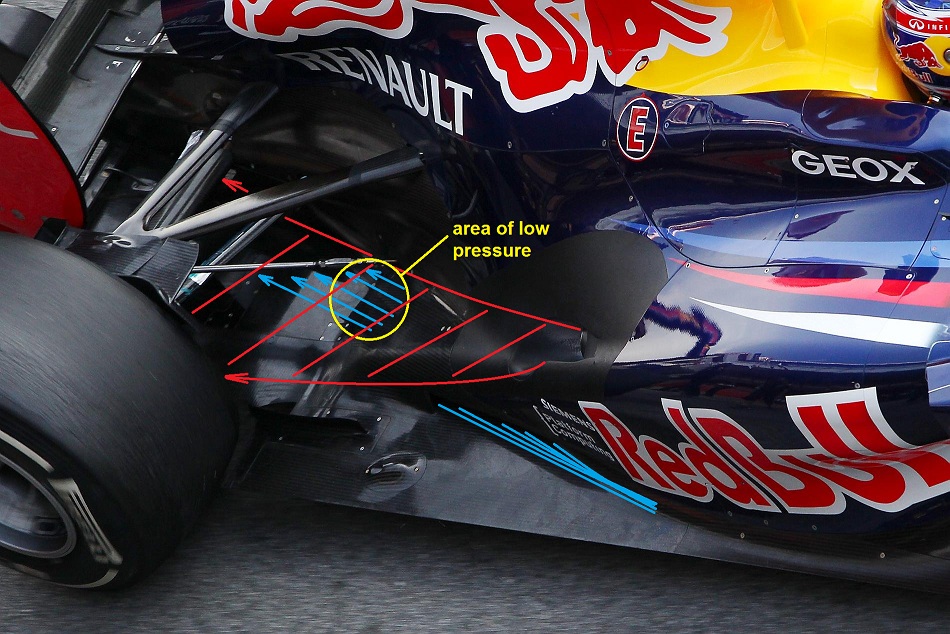
- Login or Register
No account yet? Sign up

I like it.beelsebob wrote:So... I engaged my adian newey style air flow visualisation mode... Here's a more detailed diagram of what I'd expect than before... Can anyone suggest any of the flow lines that they think don't meat their theory of what's going on?
[img]http://f.cl.ly/items/2G3T3T3n0u3N333Q0B ... ow.png[img]
based on the mercedes similar exhaust positioning and the scorched paint we saw on their car i recken the exhaust spread is far greater than people imagine.beelsebob wrote:So... I engaged my adian newey style air flow visualisation mode... Here's a more detailed diagram of what I'd expect than before... Can anyone suggest any of the flow lines that they think don't meat their theory of what's going on?

Why would the yellow and light green air be drawn into the tunnel?beelsebob wrote:So... I engaged my adian newey style air flow visualisation mode... Here's a more detailed diagram of what I'd expect than before... Can anyone suggest any of the flow lines that they think don't meat their theory of what's going on?
I still dont see how you think the exhaust gases are going to take such a drastic/immediate change of direction and why are you ignoring any influence from the green line coming around the side of the sidepod or any of the air on the top of the sidepod?beelsebob wrote:So... I engaged my adian newey style air flow visualisation mode... Here's a more detailed diagram of what I'd expect than before... Can anyone suggest any of the flow lines that they think don't meat their theory of what's going on?
Not exactly the most refined example, but I'd agree with this a lot more than the super focused channels of air people are proposing.snoop1050 wrote:based on the mercedes similar exhaust positioning and the scorched paint we saw on their car i recken the exhaust spread is far greater than people imagine.beelsebob wrote:So... I engaged my adian newey style air flow visualisation mode... Here's a more detailed diagram of what I'd expect than before... Can anyone suggest any of the flow lines that they think don't meat their theory of what's going on?
That's a difficult question to answer. You'll have to run it parsley.raymondu999 wrote:The question is; how much thyme would you need to fully optimise the corriander effect?gridwalker wrote:A play on words ...GrizzleBoy wrote:What's the corriander effect?
The hole under the bridge takes much of that side air (like the green line) away, though not all of it. I think the intent is to leave room for the exhaust, which then flows along the side of the bridge. The exhaust channel was obviously put there for at least some of the exhaust to flow along that path. I think more will flow along that pat at lower speeds (helping to seal the diffuser), and less at higher speeds (resulting in less seal->downforce->drag).GrizzleBoy wrote:I still dont see how you think the exhaust gases are going to take such a drastic/immediate change of direction and why are you ignoring any influence from the green line coming around the side of the sidepod or any of the air on the top of the sidepod?beelsebob wrote:So... I engaged my adian newey style air flow visualisation mode... Here's a more detailed diagram of what I'd expect than before... Can anyone suggest any of the flow lines that they think don't meat their theory of what's going on?
There's still the fact that you're completely ignoring any other influence of air moving around the car.Adrian Newby wrote:The hole under the bridge takes much of that side air (like the green line) away, though not all of it. I think the intent is to leave room for the exhaust, which then flows along the side of the bridge. The exhaust channel was obviously put there for at least some of the exhaust to flow along that path. I think more will flow along that pat at lower speeds (helping to seal the diffuser), and less at higher speeds (resulting in less seal->downforce->drag).GrizzleBoy wrote:I still dont see how you think the exhaust gases are going to take such a drastic/immediate change of direction and why are you ignoring any influence from the green line coming around the side of the sidepod or any of the air on the top of the sidepod?beelsebob wrote:So... I engaged my adian newey style air flow visualisation mode... Here's a more detailed diagram of what I'd expect than before... Can anyone suggest any of the flow lines that they think don't meat their theory of what's going on?
The Mercedes exhaust wasn't designed for the same effect, and the scorch marks would be over the entire range of velocities.snoop1050 wrote:based on the mercedes similar exhaust positioning and the scorched paint we saw on their car i recken the exhaust spread is far greater than people imagine.beelsebob wrote:So... I engaged my adian newey style air flow visualisation mode... Here's a more detailed diagram of what I'd expect than before... Can anyone suggest any of the flow lines that they think don't meat their theory of what's going on?


I think the third line from the bottom (greenish) is probably wrong, and it will get pushed down by the blueish line above it, following all the other streams. Then there is nothing cutting across anything. The exhaust follows (and keeps from getting pushed inward by) the side of the bridge all the way/almost all the way to the floor. At that point, much of the air that was outside pushing in is now inside pushing out (thanks to going under the bridge) - leading the exhaust gasses right where Adrian Newey wanted them.Adrian Newby wrote:There's still the fact that you're completely ignoring any other influence of air moving around the car.GrizzleBoy wrote:The hole under the bridge takes much of that side air (like the green line) away, though not all of it. I think the intent is to leave room for the exhaust, which then flows along the side of the bridge. The exhaust channel was obviously put there for at least some of the exhaust to flow along that path. I think more will flow along that pat at lower speeds (helping to seal the diffuser), and less at higher speeds (resulting in less seal->downforce->drag).beelsebob wrote:
I still dont see how you think the exhaust gases are going to take such a drastic/immediate change of direction and why are you ignoring any influence from the green line coming around the side of the sidepod or any of the air on the top of the sidepod?
You have the exhaust air cutting across other airflows and totally ignoring other airflows around it.
The light blue one running directly over the exhaust channel for instance. THat would drag the exhaust gases upwards along the top of the rear floor area.
Then there's the green air flow that flows along the side of the sidepid that you have meeting up with the aforementioned blue line, yet the exhaust gases just ignore it in your example and just head straight for the inner edge of the wheel for some reason, cutting across multiple other aiflows at angles.
The exhaust gases will be carried by airflow around the car, there's not point showing air flowing around the car in a certain direction and then drawing the exhaust gases just going "wherever" and ignoring the airflows around it.
You even have airflows cutting across airflows that seemingly have no effect on each other near the exhaust channel area.
This is what I think and the only type of example I can take seriously in terms of exhaust gas movement.gandharva wrote:Here is my theory... Could it be that this tunnel works like a chimney?
The exhaust gases flow down the sidepod just over the rear end of the tunnel creating an area of low pressure and thus sucking more air through the tunnel. This could lead to more air on top of the floor plate which could be used to create downforce on e.g. the lower rear wing.
Without the tunnel, I think the exhaust gases would create some sort of barrier and this would lead to less air that could get routet in the direction of the rear wing.
Some shitty picture to "proof" my theory. XD
[img]http://www.abload.de/img/testyijsp.jpg[img]
